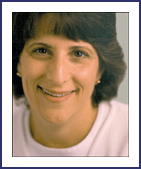Shanghai Surprise
Trading Trends With Helene Meisler Of TheStreet.com
by Jayanthi Gopalakrishnan
If you've ever traded the overseas markets, you know how confusing the time difference can be. Now imagine being on the other end of the time difference. Technician Helene Meisler of TheStreet.com, who spent more than a decade covering institutional accounts at various investment banks in New York, including Cowen & Co. and Goldman Sachs, as well as managing equity money for three years at Cargill Inc. in Minneapolis, lives and trades from Shanghai. Yes, as in China. STOCKS & COMMODITIES Editor Jayanthi Gopalakrishnan conducted this interview online with Helene Meisler on April 5, 2004.

My mentor looked at the charts and the indicators, but he also spent a lot of time on market psychology. ... I thought that was an interesting way to look at the markets, so I began to focus on that aspect too.
How did you first get interested in technical analysis?
In 1984 I was working at Cowen & Co. when technician Justin Mamis joined the firm. Mamis had been using technical analysis since the 1950s, and I found that I enjoyed his viewpoint. Eventually, I began working with him, and he became my mentor in this business. He looked at the charts and the indicators, but he also spent a lot of time on market psychology. And not just the sentiment indicators, but also the thought process behind why folks do what they do in the markets and how that translates into the charts and price action. I thought that was an interesting way to look at the markets, so I began to focus on that aspect too.
What were you doing at Cowen & Co.?
I started there in 1982 as an institutional sales assistant. The business was very different back then. The big institutions were mostly banks and pension funds; mutual funds were still a much smaller part of the business. Remember that 401(K)s only came into existence in the early 1980s. Most of the calls we made to clients were to give them earnings estimate changes, and I found that quite boring. So the prospect of working with Mamis seemed exciting.
What did you found so interesting?
Well, he looked at the market statistics, which really was my first area of interest. I began following them as soon as we started working together, and started building spreadsheets and just kept adding -- and deleting! -- statistics along the way. I also am a bit of a dinosaur in that I still hand-post about 200 daily stock charts: John Magee's semi-log charts.
Yes, I recall reading about that. So do you not use any charting software?
Software? No, I don't think I would call it software. When I want to view a chart that I don't keep -- and there are lots of those! -- I use BigCharts.com, since I think it's one of the best -- and free -- chart providers out there.
So when you say "market statistics," what type of data do you look at?
Of course I look at the advance/decline line (A/D), which is so skewed these days from all those "non-stock" stocks (preferreds and closed-end funds) and all the penny stock moves. But I also use A/D figures that have been calculated using common stocks only -- no foreign stocks and no real estate investment trusts [Reits]. Also, they must move at least 12 cents on the day to be up or down, which makes them like the old-fashioned statistics we grew up on.
Along with that, I watch the new highs and new lows. I use the ones
the exchanges publish, but I also use the common stock-only figures to
see if they say something. I like sentiment indicators as well.
...Continued in the June 2004 issue of Technical Analysis of STOCKS & COMMODITIES
Excerpted from an article originally published in the June 2004 issue of Technical Analysis of STOCKS & COMMODITIES magazine. All rights reserved. © Copyright 2004, Technical Analysis, Inc.